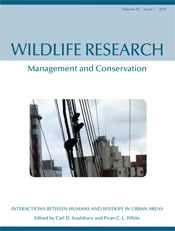
Wildlife Research
Volume 42 Number 7 2015
Interactions Between Humans and Wildlife in Urban Areas
WR14229Human–wildlife interactions in urban areas: a review of conflicts, benefits and opportunities
There is a pressing need to understand the type and nature of human–wildlife interactions within urban environments, to help manage, mitigate or even promote these interactions. There is an inherent bias in the literature towards quantifying and assessing human–wildlife conflict, whereas the benefit wildlife brings to urban areas is poorly characterised, but includes benefits such as ecosystem services and through to health and wellbeing. Research is critically needed to improve our understanding in this area, requiring wildlife biologists to work with other research disciplines.
WR15007A cross-continental look at the patterns of avian species diversity and composition across an urbanisation gradient

As the world becomes more urban, the importance of protecting wildlife in urban areas increases. We found that certain bird species do better in human-dominated areas, in particular those that use bird feeders. In order to conserve the greatest bird diversity in urban areas, urban planners and residents should provide a variety of habitats, supplemental natural foods and nesting places for birds. Photograph by Jacob Clifford.
WR14228Spotted hyena (Crocuta crocuta) concentrate around urban waste dumps across Tigray, northern Ethiopia

The spotted hyena lives in remarkably close proximity to humans in the degraded and prey-depleted landscapes in Tigray, northern Ethiopia. We sought to provide an estimate of hyena abundance at garbage dumps and open agricultural areas. A very large hyena population persists in unprotected areas of Tigray, where they concentrate around urban waste dumps at night for scavengeable food resources. Photograph by Gidey Yirga.
WR15143Evaluating patterns of human–reptile conflicts in an urban environment
City inhabitants have a range of perceptions about urban reptiles. Whereas some species are kept as pets, others are seen as a significant threat. We investigated the patterns of human–reptile conflicts in a large Brazilian city. The density of human–reptile conflicts was related to socio-economic factors and landscape composition, thereby suggesting particular management actions.
WR14148Good neighbours: distribution of black-tufted marmoset (Callithrix penicillata) in an urban environment

The increasing growth of human urban populations leads to complex alterations of landscapes, the effects of which on wildlife are not fully understood. The way wildlife responds to such impacts is an important aspect to be considered in urban planning and management. We found that marmoset groups were found in green areas surrounded by highly populated areas; however, socioeconomical factors were significantly related to the occurrence of primate groups.

To successfully inhabit cities, birds must be inherently able or learn to cope with high volumes of pedestrian and vehicular traffic. This study showed that urban little ravens were much more tolerant of approaches by pedestrians than their exurban counterparts, but urban individuals living in high- and low-volume traffic areas varied little in their tolerance of human proximity and a simulated vehicle sound. A high level of boldness appears to be important in facilitating urban-living by native little ravens and may be genetically and/or learning-based.
WR15003The fancy city life: Kuhl's pipistrelle, Pipistrellus kuhlii, benefits from urbanisation

Understanding why some species benefit from urbanisation is central for appropriate wildlife management in human-dominated ecosystems. We found that the bat Pipistrellus kuhlii, increasing its range across Europe, obtains major reproductive advantages in urban areas. Although this fitness advantage may help explain the observed increase in geographical distribution, a positive effect of climate change on this warm-adapted bat cannot be ruled out. Photograph by Jens Rydell.
WR14184Achieving positive social outcomes through participatory urban wildlife conservation projects
We evaluated the personal and social outcomes experienced by participants as a result of their involvement in a wildlife conservation project in the city of Hull, UK. We found that participation was a positive experience for the volunteers, leading to both personal and wider social benefits. Such benefits can be maximised by linking volunteering opportunities with pre-existing community-based networks that can act as advocates for conservation.



